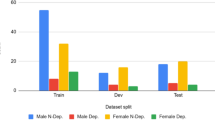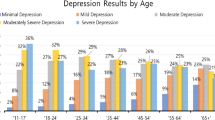Abstract
Depression is the most prevalent mental disorder in the world. One of the most adopted tools for depression screening is the Beck Depression Inventory-II (BDI-II) questionnaire. Patients may minimize or exaggerate their answers. Thus, to further examine the patient’s mood while filling in the questionnaire, we propose a mobile application that captures the BDI-II patient’s responses together with their images and speech. Deep learning techniques such as Convolutional Neural Networks analyze the patient’s audio and image data. The application displays the correlation between the patient’s emotional scores and DBI-II scores to the clinician at the end of the questionnaire, indicating the relationship between the patient’s emotional state and the depression screening score. We conducted a preliminary evaluation involving clinicians and patients to assess (i) the acceptability of proposed application for use in clinics and (ii) the patient user experience. The participants were eight clinicians who tried the tool with 21 of their patients. The results seem to confirm the acceptability of the app in clinical practice.










Similar content being viewed by others
Explore related subjects
Discover the latest articles and news from researchers in related subjects, suggested using machine learning.Data Availability
The datasets generated and analysed during the current study are available from the corresponding author on reasonable request.
Notes
References
Badshah AM, Ahmad J, Rahim N, Baik SW (2017) Speech emotion recognition from spectrograms with deep convolutional neural network. In: 2017 international conference on platform technology and service (PlatCon). IEEE, pp 1–5
Beck AT (1979) Cognitive therapy of depression guilford press
Beck AT, Steer RA, Brown G (1996) Beck depression inventory–ii psychological assessment
Beck AT, Ward CH, Mendelson M, Mock J, Erbaugh J (1961) An inventory for measuring depression. Archives of general psychiatry 4(6):561–571
Bertero D, Fung P (2017) A first look into a convolutional neural network for speech emotion detection. In: 2017 IEEE international conference on acoustics, speech and signal processing (ICASSP). IEEE, pp 5115–5119
(2022). CDC: depression evaluation measures. https://www.cdc.gov/workplacehealthpromotion/health-strategies/depression/evaluation-measures/index.html. Accessed 15 Dec 2022
De Melo WC, Granger E, Hadid A (2019) Depression detection based on deep distribution learning. In: 2019 IEEE international conference on image processing (ICIP), pp 4544–4548. https://doi.org/10.1109/ICIP.2019.8803467
Denecke K, Vaaheesan S, Arulnathan A (2021) A mental health chatbot for regulating emotions (sermo) - concept and usability test. IEEE Trans Emerging Topics Comput 9(3):1170–1182. https://doi.org/10.1109/TETC.2020.2974478
Deshpande M, Rao V (2017) Depression detection using emotion artificial intelligence. In: 2017 international conference on intelligent sustainable systems (ICISS). IEEE, pp 858–862
Ekman P (1999) Basic emotions. Handbook Cognit Emotion 98 (45-60):16
Ezz-Eldin M, Khalaf AAM, Hamed HFA, Hussein AI (2021) Efficient feature-aware hybrid model of deep learning architectures for speech emotion recognition. IEEE Access 9:19999–20011. https://doi.org/10.1109/ACCESS.2021.3054345
Flint AJ, Black SE, Campbell-Taylor I, Gailey GF, Levinton C (1993) Abnormal speech articulation, psychomotor retardation, and subcortical dysfunction in major depression. J Psychiatric Res 27(3):309–319
Francese R, Attanasio P (2021) Supporting depression screening with multimodal emotion detection. In: Angeli AD, Chittaro L, Gennari R, Marsico MD, Melonio A, Gena C, Russis LD, Spano LD (eds) Proceedings of the 14th biannual conference of the italian SIGCHI chapter, CHItaly ’21, Bozen-Bolzano, Italy, and online (www). ACM, 11-13 July 2021, pp 7–178
Francese R, Risi M, Tortora G (2020) A user-centered approach for detecting emotions with low-cost sensors. Multim Tools Appl 79(47):35885–35907. https://doi.org/10.1007/s11042-020-09576-0
Hamiditabar N, Chalechale A, Kabudian SJ (2022) Determining the severity of depression in speech based on combination of acoustic-space and score-space features. In: 2022 9th Iranian joint congress on fuzzy and intelligent systems (CFIS), pp 1–5. https://doi.org/10.1109/CFIS54774.2022.9756429
Hamilton D, Lane JV, Gaston P, Patton J, Macdonald D, Simpson A, Howie C (2014) Assessing treatment outcomes using a single question: the net promoter score. Bone Joint J 96(5):622–628
Hauke J, Kossowski T (2011) Comparison of values of pearson’s and spearman’s correlation coefficients on the same sets of data. Quaestiones Geographicae 30(2):87–93
He L, Cao C (2018) Automated depression analysis using convolutional neural networks from speech. J Biomed Inf 83:103–111
Jan A, Meng H, Gaus YFBA, Zhang F (2017) Artificial intelligent system for automatic depression level analysis through visual and vocal expressions. IEEE Trans Cognit Develop Syst 10(3):668–680
Korszun A (2002) Facial pain, depression and stress–connections and directions. J Oral Pathology Med 31(10):615–619
Laflamme L, Chipps J, Fangerau H, Juth N, Légaré F, Sawe H, Wallis L (2019) Targeting ethical considerations tied to image-based mobile health diagnostic support specific to clinicians in low-resource settings: the brocher proposition. Glob Health Action 12(1):1666695
Lemey C, Larsen ME, Devylder J, Courtet P, Billot R, Lenca P, Walter M, Baca-García E, Berrouiguet S (2019) Clinicians’ concerns about mobile ecological momentary assessment tools designed for emerging psychiatric problems: prospective acceptability assessment of the memind app. J Med Internet Res 21(4):10111
Likforman-Sulem L, Esposito A, Faundez-Zanuy M, Clémençon S, Cordasco G (2017) Emothaw: a novel database for emotional state recognition from handwriting and drawing. IEEE Trans Human-Mach Syst 47(2):273–284
Lu X, Shi D, Liu Y, Yuan J (2021) Speech depression recognition based on attentional residual network. Frontiers Bioscience-Landmark 26 (12):1746–1759
Mao Q, Dong M, Huang Z, Zhan Y (2014) Learning salient features for speech emotion recognition using convolutional neural networks. IEEE Trans Multimed 16(8):2203–2213
McPherson A, Martin C (2010) A narrative review of the beck depression inventory (bdi) and implications for its use in an alcohol-dependent population. J Psychiatr Ment Health Nurs 17(1):19–30
Morris RR, Schueller SM, Picard RW (2015) Efficacy of a web-based, crowdsourced peer-to-peer cognitive reappraisal platform for depression: randomized controlled trial. J Med Internet Res 17(3):4167
Mouchet-Mages S, Baylé FJ (2022) Sadness as an integral part of depression Dialogues in clinical neuroscience
Mukaka MM (2012) A guide to appropriate use of correlation coefficient in medical research. Malawi Med J 24(3):69–71
Mulay A, Dhekne A, Wani R, Kadam S, Deshpande P, Deshpande P (2020) Automatic depression level detection through visual input. In: 2020 fourth world conference on smart trends in systems, security and sustainability (worldS4). IEEE, pp 19–22
Nakamura R, Mitsukura Y (2018) Feature analysis of electroencephalography in patients with depression. In: 2018 IEEE life sciences conference (LSC). IEEE, pp 53–56
Niu M, Tao J, Liu B, Huang J, Lian Z (2020) Multimodal spatiotemporal representation for automatic depression level detection. IEEE Trans Affect Comput
Pampouchidou A, Simantiraki O, Vazakopoulou C-M, Chatzaki C, Pediaditis M, Maridaki A, Marias K, Simos P, Yang F, Meriaudeau F et al (2017) Facial geometry and speech analysis for depression detection. In: 2017 39th annual international conference of the IEEE engineering in medicine and biology society (EMBC). IEEE, pp 1433–1436
Parada-Cabaleiro E, Costantini G, Batliner A, Schmitt M, Schuller BW (2019) Demos: an italian emotional speech corpus. Lang Resour Eval:1–43
Russell JA (1980) A circumplex model of affect. J Personality Social Psychol 39(6):1161
Schrepp M (2015) User experience questionnaire handbook all you need to know to apply the UEQ successfully in your project
Shi D, Lu X, Liu Y, Yuan J, Pan T, Li Y (2021) Research on depression recognition using machine learning from speech. In: 2021 international conference on asian language processing (IALP), pp 52–56. https://doi.org/10.1109/IALP54817.2021.9675271
Sumali B, Mitsukura Y, Tazawa Y, Kishimoto T (2019) Facial landmark activity features for depression screening. In: 2019 58th annual conference of the society of instrument and control engineers of Japan (SICE), pp 1376–1381. https://doi.org/10.23919/SICE.2019.8859798
Tadalagi M, Joshi AM (2021) Autodep: automatic depression detection using facial expressions based on linear binary pattern descriptor. Med Biol Eng Comput:1–16
Tariman JD, Berry DL, Halpenny B, Wolpin S, Schepp K (2011) Validation and testing of the acceptability e-scale for web-based patient-reported outcomes in cancer care. Appl Nurs Res 24(1):53–58
Tasnim M, Stroulia E (2019) Detecting depression from voice. In: Canadian conference on artificial intelligence. Springer, pp 472–478
Torous J, Onnela J, Keshavan M (2017) New dimensions and new tools to realize the potential of rdoc: digital phenotyping via smartphones and connected devices. Trans Psych 7(3):1053–1053
Valstar M, Schuller B, Smith K, Almaev T, Eyben F, Krajewski J, Cowie R, Pantic M (2014) Avec 2014: 3d dimensional affect and depression recognition challenge. In: Proceedings of the 4th international workshop on audio/visual emotion challenge, pp 3–10
Verde L, Raimo G, Vitale F, Carbonaro B, Cordasco G, Marrone S, Esposito A (2021) A lightweight machine learning approach to detect depression from speech analysis. In: 2021 IEEE 33rd international conference on tools with artificial intelligence (ICTAI), pp 330–335. https://doi.org/10.1109/ICTAI52525.2021.00054
Wohlin C, Runeson P, Hst M, Ohlsson MC, Regnell B, Wessln A (2012) Experimentation in software engineering. Springer
(2017). World health organization: world health day 2017 - depression: let’s talk. https://www.who.int/newsroom/events/detail/2017/04/07/default-calendar/world-health-day-2017. Accessed 15 Dec 2022
Yang L (2019) Multi-modal depression detection and estimation. In: 2019 8th international conference on affective computing and intelligent interaction workshops and demos (ACIIW). IEEE, pp 26–30
Zhou X, Jin K, Shang Y, Guo G (2018) Visually interpretable representation learning for depression recognition from facial images. IEEE Trans Affect Comput 11(3):542–552
Acknowledgements
Many thanks to all the anonymous participants involved in the evaluation and to the anonymous reviewers that largely improved the paper quality with their valuable suggestions.
Funding
No funding was received for conducting this study.
Author information
Authors and Affiliations
Corresponding author
Ethics declarations
Conflict of Interests
The authors have no financial or proprietary interests in any material discussed in this article.
Additional information
Ethical concerns
The evaluation procedure described in this paper obtained the ethical approval n. 0001 by the Ethic Committee of the Computer Science Department of the University of Salerno.
Publisher’s note
Springer Nature remains neutral with regard to jurisdictional claims in published maps and institutional affiliations.
Pasquale Attanasio contributed equally to this work.
Rights and permissions
Springer Nature or its licensor (e.g. a society or other partner) holds exclusive rights to this article under a publishing agreement with the author(s) or other rightsholder(s); author self-archiving of the accepted manuscript version of this article is solely governed by the terms of such publishing agreement and applicable law.
About this article
Cite this article
Francese, R., Attanasio, P. Emotion detection for supporting depression screening. Multimed Tools Appl 82, 12771–12795 (2023). https://doi.org/10.1007/s11042-022-14290-0
Received:
Revised:
Accepted:
Published:
Issue Date:
DOI: https://doi.org/10.1007/s11042-022-14290-0




